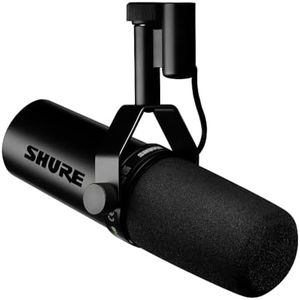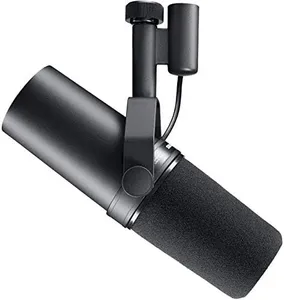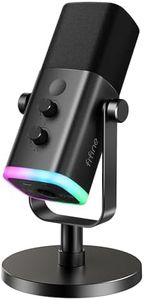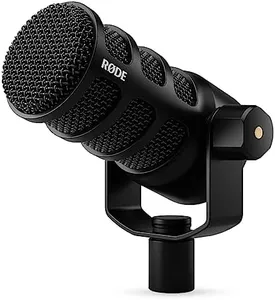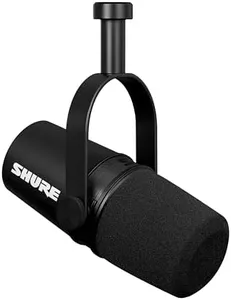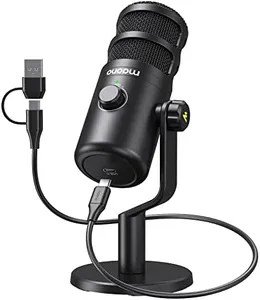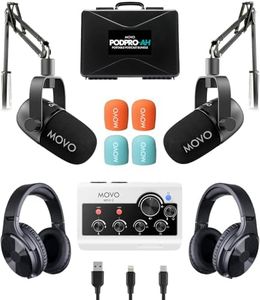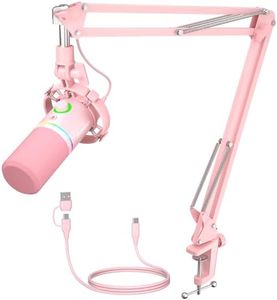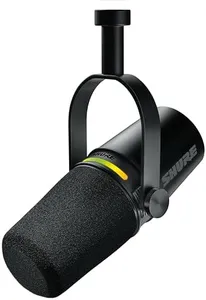10 Best Dynamic Microphones 2025 in the United States
Our technology thoroughly searches through the online shopping world, reviewing hundreds of sites. We then process and analyze this information, updating in real-time to bring you the latest top-rated products. This way, you always get the best and most current options available.

Our Top Picks
Winner
Shure SM7dB Dynamic Vocal Microphone with Built-in Preamp – Studio Mic for Streaming, Podcasting, and Recording – Smooth Sound, Wide Frequency Range, Rugged Build, Windscreen Included, Black
Most important from
12544 reviews
The Shure SM7dB is a solid choice for anyone needing a dynamic microphone for streaming, podcasting, or recording. It features a wide frequency response (50 to 20,000 Hz) that captures both highs and lows clearly, giving you a warm and smooth sound that many broadcasters and vocalists appreciate. Its cardioid polar pattern is great at picking up your voice while reducing background noise, which is important if your recording environment isn’t perfectly quiet. One of the stand-out features is the built-in preamp, offering up to 28 dB of clean gain. This means you can boost quieter voices or instruments without needing extra equipment, making it handy for beginners or those wanting a simpler setup. You also have the option to bypass the preamp if you prefer to use your own gear.
The microphone's design is rugged and durable, suitable for regular use and travel, and it comes with a detachable windscreen to reduce popping sounds. On the downside, the SM7dB is relatively heavy compared to some other microphones, which might require a sturdy stand to hold it comfortably. While it handles noise well, like most dynamic mics, it might not capture ultra-fine details as a condenser microphone would, but this trade-off is common for its category and durability.
If you want a reliable, versatile mic that balances great sound quality with ease of use, especially in less-than-ideal spaces, the SM7dB is a strong option to consider.
Most important from
12544 reviews
Shure SM7B Vocal Dynamic Microphone – XLR Studio Mic for Podcasting, Recording, Broadcasting, Streaming & Gaming – Smooth, Warm Sound, Rugged Build, Detachable Windscreen, Wide Frequency Range, Black
Most important from
12544 reviews
The Shure SM7B is a highly regarded dynamic microphone known for its versatility, making it a great fit for various applications such as studio recording, podcasting, and streaming. One of its standout features is the smooth, flat frequency response, which delivers clean and natural sound for both vocals and instruments. Its unidirectional polar pattern effectively minimizes background noise, allowing you to capture sound from the desired source while rejecting ambient sounds. This makes it particularly useful in noisy environments.
In terms of durability, the SM7B boasts a rugged construction that can withstand the rigors of both studio and live settings. The included detachable windscreens help reduce handling noise and wind interference, enhancing your audio quality. Additionally, it has advanced electromagnetic shielding to protect against hum from other electronic devices, ensuring that your recordings are clear.
However, there are some considerations to keep in mind. The microphone requires a solid audio interface or preamp with at least 60dB of gain to achieve its famous warm and balanced tone, which might necessitate additional investment. It's also an XLR mic, meaning you'll need compatible cables and equipment, which might be a hurdle for beginners. Another potential drawback is its weight; at 2.7 pounds, it's heavier than some other options in the market, which could be cumbersome for certain setups.
Most important from
12544 reviews
FIFINE USB/XLR Dynamic Microphone for Podcast Recording, PC Computer Gaming Streaming Mic with RGB Light, Mute Button, Headphones Jack, Desktop Stand, Vocal Mic for Singing YouTube-AmpliGame AM8
Most important from
9376 reviews
The FIFINE AM8 dynamic microphone is a versatile choice for podcasting, gaming, and streaming, offering a natural sound quality with its 50Hz-16kHz frequency range that captures clear and balanced audio. Its unidirectional (cardioid) polar pattern helps focus on your voice while reducing background noise, making it great for recording in busy or noisy environments. You can connect it either via USB for easy plug-and-play use or XLR for more professional setups, although the XLR cable is not included.
The USB mode includes handy features like a mute button with LED indicator, a headphone jack for real-time monitoring, and volume controls, which are very convenient for live streaming and gaming sessions. The mic’s durable build with metal and ABS plastic materials, plus a noise-canceling windscreen, helps minimize unwanted handling noise and electrical hum, adding to its reliability. The inclusion of an RGB light ring is a nice touch for gamers who want to match their gear’s aesthetics. However, some features such as mute, RGB lighting, and headphone monitoring only work when using USB, limiting functionality if you use the XLR connection.
While the mic stand is included, you’ll need to provide your own XLR cable and potentially a boom arm for flexible positioning. This microphone suits beginners or intermediate users who want a straightforward setup with room to upgrade their audio gear later. For those seeking a mic that works well right out of the box for recording, streaming, or gaming with useful controls and decent durability, the FIFINE AM8 presents a solid option.
Most important from
9376 reviews
Buying Guide for the Best Dynamic Microphones
When choosing a dynamic microphone, it's important to consider several key specifications to ensure you select the best fit for your needs. Dynamic microphones are known for their durability and ability to handle high sound pressure levels, making them ideal for live performances and certain recording situations. Understanding the key specs will help you make an informed decision based on your specific requirements.FAQ
Most Popular Categories Right Now


